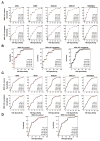A Panel of Methylated MicroRNA Biomarkers for Identifying High-Risk Patients With Ulcerative Colitis-Associated Colorectal Cancer
- PMID: 28847750
- PMCID: PMC5748293
- DOI: 10.1053/j.gastro.2017.08.037
A Panel of Methylated MicroRNA Biomarkers for Identifying High-Risk Patients With Ulcerative Colitis-Associated Colorectal Cancer
Abstract
Background & aims: Methylation of specific microRNAs (miRNAs) often occurs in an age-dependent manner, as a field defect in some instances, and may be an early event in colitis-associated carcinogenesis. We aimed to determine whether specific mRNA signature patterns (MIR1, MIR9, MIR124, MIR137, MIR34B/C) could be used to identify patients with ulcerative colitis (UC) who are at increased risk for colorectal neoplasia.
Methods: We obtained 387 colorectal tissue specimens collected from 238 patients with UC (152 without neoplasia, 17 with dysplasia, and 69 with UC-associated colorectal cancer [UC-CRC]), from 2 independent cohorts in Japan between 2005 and 2015. We quantified methylation of miRNAs by bisulfite pyrosequencing analysis. We analyzed clinical data to determine whether miRNA methylation patterns were associated with age, location, or segment of the colorectum (cecum, transverse colon, and rectum). Differences in tissue miRNA methylation and expression levels were compared among samples and associated with cancer risk using the Wilcoxon, Mann-Whitney, and Kruskal-Wallis tests as appropriate. We performed a validation study of samples from 90 patients without UC and 61 patients with UC-associated dysplasia or cancer to confirm the association between specific methylation patterns of miRNAs in non-tumor rectal mucosa from patients with UC at risk of UC-CRC.
Results: Among patients with UC without neoplasia, rectal tissues had significantly higher levels of methylation levels of MIR1, MIR9, MIR124, and MIR137 than in proximal mucosa; levels of methylation were associated with age and duration of UC in rectal mucosa. Methylation of all miRNAs was significantly higher in samples from patients with dysplasia or CRC compared with samples from patients without neoplasia. Receiver operating characteristic analysis revealed that methylation levels of miRNAs in rectal mucosa accurately differentiated patients with CRC from those without. Methylation of MIR137 in rectal mucosa was an independent risk factor for UC-CRC. Methylation patterns of a set of miRNAs (panel) could discriminate discriminate UC patients with or without dysplasia or CRC in the evaluation cohort (area under the curve, 0.81) and the validation cohort (area under the curve, 0.78).
Conclusions: In evaluation and validation cohorts, we found specific miRNAs to be methylated in rectal mucosal samples from patients with UC with dysplasia or CRC compared with patients without neoplasms. This pattern also associated with patient age and might be used to identify patients with UC at greatest risk for developing UC-CRC. Our findings provide evidence for a field defect in rectal mucosa from patients with UC-CRC.
Keywords: Colitis-Associated Cancer; MIR1; MIR124; MIR137; MIR34B/C; MIR9; Methylation; Ulcerative Colitis.
Copyright © 2017 AGA Institute. Published by Elsevier Inc. All rights reserved.
Conflict of interest statement
The authors disclose no conflicts.
Figures




Comment in
-
Methylated MicroRNA Biomarkers for Identifying Ulcerative Colitis-Associated Colorectal Cancers.Gastroenterology. 2018 May;154(6):1852. doi: 10.1053/j.gastro.2017.12.048. Epub 2018 Apr 3. Gastroenterology. 2018. PMID: 29621516 No abstract available.
-
Chronic Pancreatitis Prognosis Score System Is Not Ready Yet.Gastroenterology. 2018 May;154(6):1852-1853. doi: 10.1053/j.gastro.2017.11.297. Epub 2018 Apr 3. Gastroenterology. 2018. PMID: 29621518 No abstract available.
-
Reply.Gastroenterology. 2018 Jun;154(8):2274-2275. doi: 10.1053/j.gastro.2018.05.013. Epub 2018 May 8. Gastroenterology. 2018. PMID: 29750909 No abstract available.
References
-
- Kornbluth A, Sachar DB. Ulcerative colitis practice guidelines in adults (update): American College of Gastroenterology, Practice Parameters Committee. Am J Gastroenterol. 2004;99:1371–1385. - PubMed
-
- Fujii S, Fujimori T, Chiba T, et al. Efficacy of surveillance and molecular markers for detection of ulcerative colitis-associated colorectal neoplasia. J Gastroenterol. 2003;38:1117–1125. - PubMed
-
- Issa JP. Aging, DNA methylation and cancer. Crit Rev Oncol Hematol. 1999;32:31–43. - PubMed
Publication types
MeSH terms
Substances
Grants and funding
LinkOut - more resources
Full Text Sources
Other Literature Sources
Medical

